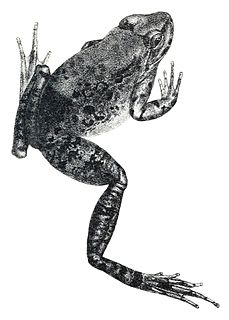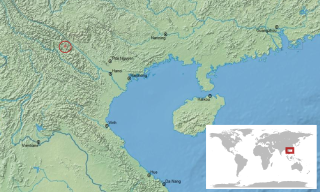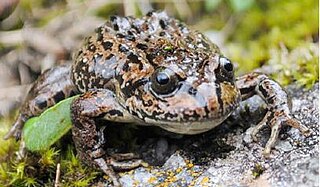
Nanorana is a genus of dicroglossid frogs. They are found in Asia, from the Himalayan region of northern Pakistan and northern India, Nepal, and western China east to montane southern China and southeast to Myanmar, Thailand, Laos, and northern Vietnam. Common names of these frogs reflect the complex taxonomic history of the genus and include Yunnan slow frogs and High Himalaya frogs.

Leptolalax bourreti is a frog species in the family Megophryidae. It is known with certainty only from the vicinity of its type locality in Sa Pa in northern Vietnam. Earlier records from Laos refer to Leptolalax eos and those from Thailand probably to an unnamed species. Its natural habitats are subtropical moist lowland forests, moist montane forests, and rivers. Its status is insufficiently known.

Leptolalax pluvialis is a frog species in the family Megophryidae. It is only known from its type locality, Fansipan mountain range in northern Vietnam, although it is expected to be found also in adjacent Yunnan, China. Its natural habitats are subtropical moist montane forests and rivers. Its status is insufficiently known.
Kalophrynus robinsoni is a species of frog in the family Microhylidae. It is endemic to Pahang in central Peninsular Malaysia. The specific name robinsoni honours Herbert C. Robinson, a British zoologist and ornithologist. This poorly known species has not been reported since 1922.
Nanorana quadranus is a species of frog in the family Dicroglossidae. It is endemic to central China. Its natural habitats are temperate forest and shrubland, with breeding taking place in small rivers. It is a common species believed to be declining. It is threatened by collection for food and also habitat loss.
Nanorana unculuanus is a species of frog in the family Dicroglossidae. It is endemic to central and southern Yunnan, China, although it is expected to have wider distribution than currently known, possibly extending into Vietnam. Its natural habitats are fast-flowing hill streams and riparian habitats in forests and grasslands, but also man-made habitats like roadside drainage ditches and ponds. It is a rare and secretive species that appears to be declining. It is currently threatened by collection for food and also by habitat loss.
Quasipaa yei, or Ye's spiny-vented frog, is a species of frog in the family Dicroglossidae. It is endemic to China where it is known from the Dabie Mountains that straddle the border between Hubei, Henan, and Anhui provinces. Its type locality is in Shengcheng County in Jiyuan City, Henan. Its natural habitats are temperate rivers with surrounding forests. It is potentially threatened by habitat loss.
Nanorana parkeri is a species of frogs in the family Dicroglossidae. It is found in Tibet (China) and in Nepal, but it is expected to be found also in Bhutan and parts of India. It is the second amphibian, and the first Neobatrachian, to have its whole genome published.

Nanorana pleskei is a species of frog in the family Dicroglossidae. Until recently it has been only known from southwestern/central western China from elevations between 3,300–4,500 m (10,800–14,800 ft), but there is now one record also from Bhutan. Notice, however, that earlier records outside China have turned out to be misidentifications.
Nanorana ventripunctata is a species of frog in the family Dicroglossidae. It is endemic to northwestern Yunnan, China. It inhabits lakes, pools and ponds in alpine areas, occurring near streams and rivers in open, high-elevation habitats. It breeds in still-water pools and ponds.

Nanorana conaensis is a species of frog in the family Dicroglossidae. Its name refers to its type locality, Mama in Cona County in Tibet. Note that while large parts of Cona County are located within Arunachal Pradesh in the area that is controlled by India but claimed by China, Mama is on the Tibetan side of the border. It has recently been reported also from Bhutan. Its natural habitats are subtropical moist montane forest, high-altitude shrubland, and rivers.

Nanorana liebigii, also known as Sikkim paa frog, Liebig's paa frog, Liebig's frog, and spiny-armed frog, is a species of frog in the family Dicroglossidae. It is found in the Himalayas, specifically in Bhutan, southern Tibet (China), northern India, and Nepal. The specific name liebigii honours a certain "Dr von Liebig Jr.", likely referring to Justus von Liebig, German botanist and chemist.
Nanorana medogensis is a species of frog in the family Dicroglossidae. It is endemic to Tibet, China, and only known from near its type locality in Mêdog County in southeastern Tibet, near the Indian border. It lives in forested streams, and is sometimes also found at the edges of pools and ponds.

Nanorana mokokchungensis is a species of frog in the family Dicroglossidae. It is endemic to Northeast India and only known from its type locality, Mokokchung in Nagaland.
Nanorana polunini is a species of frog in the family Dicroglossidae. It is found in Nyalam County in southern Tibet (China), Nepal, and possibly Kashmir (India). It is a common species in Nepal but rare in China. It lives in stream habitats in montane forest.
Nanorana rarica is a frog species in the family Dicroglossidae. It is endemic to western Nepal. Its type locality is the eponymous Rara Lake located in the Rara National Park.
Nanorana taihangnica, or the Taihangshan swelled-vented frog, is a species of frog in the family Dicroglossidae. It is endemic to central China. Its type locality is on the Taihang Mountains, within the Jiyuan city in Henan province of central China. It is now also reported from Qin, Funiu and Zhongtiao Mountains, with its distribution also including Gansu and Shaanxi provinces. There is substantial differentiation among lineages from different mountains.
Nanorana yunnanensis, commonly known as Yunnan paa frog, Yunnan spiny frog, Bourret's paa frog or Bourret's frog, is a species of frog in the family Dicroglossidae. It is found in southwestern China, Vietnam, Myanmar, northern Thailand, and likely in the intervening Laos. Its natural habitats are small and large streams in montane forests, scrub vegetation and grasslands, and it has also been found in ditches. It is threatened primarily by collection for human consumption, but also by habitat loss caused by agricultural development and infrastructure development.
Feihyla palpebralis is a species of frog in the family Rhacophoridae, sometimes known as the Vietnamese bubble-nest frog or the white-cheeked small treefrog. In addition to its type locality, Langbian Plateau in southeastern Vietnam, it is found in southern China and northern Vietnam south to Tam Dao, and is expected to be found in the intervening Laos and Vietnam.
Polypedates mutus is a species of frog in the family Rhacophoridae. It is found in southern and southwestern China, Myanmar, Laos, Thailand, and Vietnam. However, it may actually represent two different species. It is not known which one of these is the "true" Polypedates mutus as specimens from the type locality in northern Myanmar have not been analysed. Its natural habitats are forests and the surrounding areas. It breeds in standing water. It is suffering from habitat loss.








